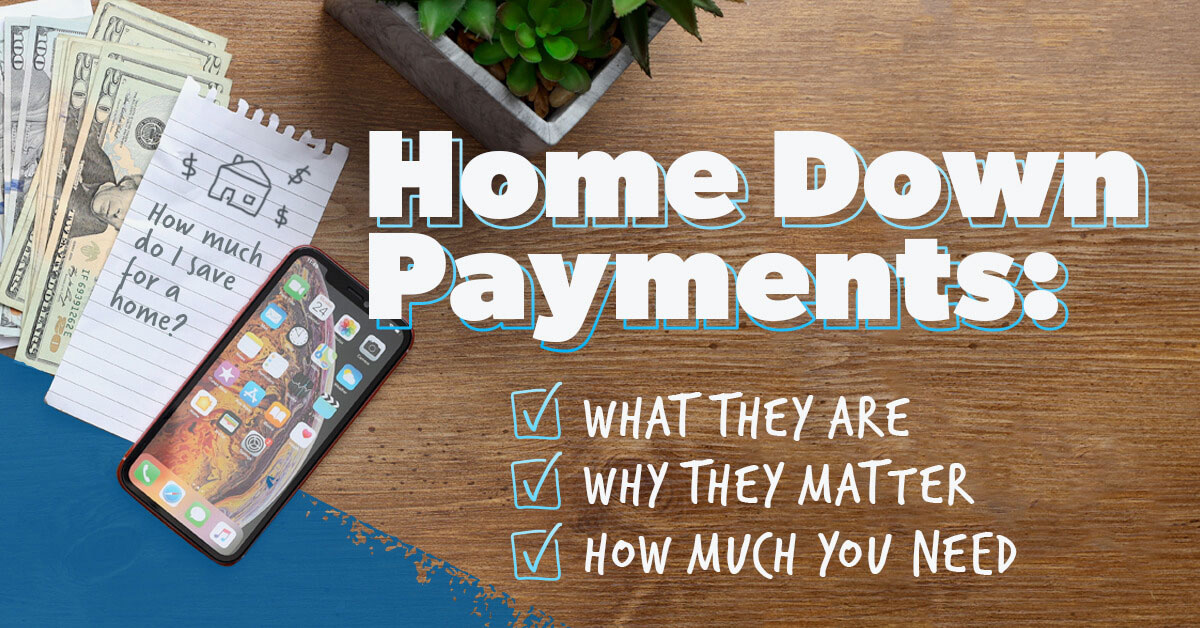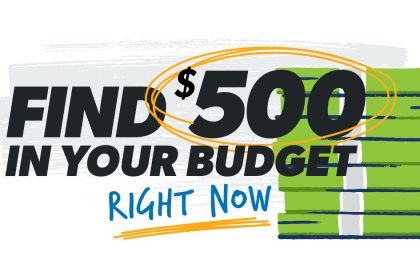Saving for a house is no walk in the park—unless that park is a mountain. In fact, nearly 3 of every 10 first-time home buyers say the most difficult step in the home-buying process is saving for a down payment.1 But when you set a clear goal, you can see a light at the end of the tunnel. So let’s figure out how much of a down payment you need so you know what to shoot for.
What’s a good down payment amount? Well, everyone has a different idea on this. But if you want your home to be a blessing, not a curse, you need to get this right. We’ll walk you through the smartest way to decide how much of a down payment you need.
But first, let’s be clear on what exactly a home down payment is.
What Is a Down Payment?
A down payment is a portion of the total home price you pay out of pocket before financing the rest with a mortgage.
How Much Should I Pay for a Down Payment?
Aim for a down payment that’s 20% or more of the total home price—that’s $40,000 for a $200,000 house. This minimum is partially based on guidelines set by government-sponsored companies like Fannie Mae and Freddie Mac. Anything less than 20% is considered riskier for a lender—so to cover their butts, they make the mortgage more expensive for you by adding things like private mortgage insurance (PMI).2
If this isn’t your first time buying a house, you’ve probably built up some serious equity in your current home by paying down your mortgage—and rising home prices have added even more equity. That makes a 20% down payment easier to reach. All you have to do is sell your current home to tap into that equity and—presto!—you have yourself a huge down payment for your next home.
If you’re a first-time home buyer, a smaller down payment of 5–10% is okay too—but then you will have to pay that monthly PMI fee.
No matter what, make sure your mortgage payment is no more than 25% of your monthly take-home pay on a 15-year fixed-rate conventional loan (the overall, lowest total cost mortgage). Otherwise, you’ll be charged so much extra in interest and fees. It’s not worth it! You need that extra money to tackle home maintenance and your other financial goals.
FYI: That 25% maximum mortgage payment includes principal, interest, property tax, home insurance, PMI and homeowners association (HOA) fees.
How Much Does the Average Person Put Down on a House?
These days, the median down payment is 12%. Not too bad since that’s within our recommended 5–20% range, right? Still, you don’t want to just join the bandwagon because down payment amounts have significantly decreased over time. Not to bore you with a history lesson, but around 30 years ago the median down payment for all buyers was at a much healthier 20%.3
Dave Ramsey recommends one mortgage company. This one!
The reasons today’s buyers say they struggle to save a bigger down payment are all debt-related: student loans (51%), credit card debt (45%) and car loans (38%).4 That’s why we teach people to pay off 100% of their consumer debt and save a fully funded emergency fund (3–6 months of living expenses) before saving for a house. That way, you’ll have enough room in your budget to save for a big down payment faster and have cash to cover unexpected home repairs.
Do You Have to Put 20% Down on a House?
There are ways to buy a house with a down payment less than 20%. We already mentioned how a down payment of 5–10% is doable for first-time home buyers. But beware! Some mortgage programs allow you to buy a house with a down payment as low as 3.5%—or even no down payment at all! That may sound tempting on the front end, but don’t be fooled.
Anything less than 5–10% is actually a very weak down payment, not to mention a sure-fire way to wind up upside down on a home. And you’ll waste a lot of money in interest and fees over the life of your mortgage.
Is 5–10% Down Enough on a House?
Remember, if you’re a first-time home buyer, a 5–10% down payment is fine. Keep in mind, any down payment less than 20% will come with that monthly PMI fee, which will increase your monthly mortgage payments. But as long as your mortgage payment is no more than 25% of your monthly take-home pay on a 15-year fixed-rate conventional loan—you’ll be okay. Whatever you do, stay away from FHA and VA loans (more on these next).
How Low-Down-Payment Mortgages Actually Rip You Off
“Special” mortgage programs—ones that allow you to put next to nothing down—were designed for people who can’t get approved for a mortgage that meets traditional lending guidelines. But remember, lenders who approve low-down-payment mortgages end up taking more of your money in the long run. So, are they really helping people? We don’t think so.
To safeguard yourself, here are some rip-off mortgages to avoid:
- FHA loan (Federal Housing Administration): An FHA loan allows you to purchase a house with a down payment as little as 3.5%. But in exchange, you’ll be charged an extra fee for the life of the loan—on top of all the extra interest you’ll pay and decades you’ll spend in debt for not saving up a big down payment. Bad idea.
- VA loan (U.S. Department of Veterans Affairs): If you’re a veteran, a VA loan can help you get a house with no down payment at all! But when you put zero money down, you end up paying a higher monthly payment and thousands of dollars extra in total interest. Also, VA loans come with a funding fee. No thanks.
- USDA loan (U.S. Department of Agriculture): A USDA loan is designed to help people who can’t really afford to buy a home yet get into a house with zero money down. But again, that’ll crush your financial goals over the years with all the added interest payments and extra fees! Plus, if you can’t afford to put any money down on a house, you’re not in an ideal place to be a homeowner and handle maintenance and all the other unexpected costs that come with homeownership.
How Does the Size of Your Down Payment Impact Your Mortgage?
The rule of thumb for down payments is this: A smaller down payment means you spend more on your home—a bigger down payment means you spend less. Why is this true? Because the size of your down payment impacts three things:
- The need for PMI. If your down payment is less than 20%, you have to pay a monthly fee for private mortgage insurance (PMI)—a type of insurance that protects your lender if you stop making payments on your loan. PMI can cost anywhere from 0.19–1.86% of your total annual loan amount and is added to your mortgage payment each month.5
- Your monthly mortgage payment. When you have a larger down payment, you borrow less money from a lender. And when you borrow less, you typically make smaller monthly mortgage payments, depending on the loan.
- The total cost of interest. Since interest rates are a percentage of your loan amount, this becomes a no-brainer: The more money you put down in the beginning, the less you pay in interest because your loan amount is smaller.
As an example, imagine you take out a 15-year conventional mortgage at a 4% fixed interest rate on a $200,000 house. Using our mortgage calculator, let’s find out the total cost difference between a large down payment of 20% versus a small down payment of 3%. (For simplicity, we’ll round our numbers and leave out things like property tax, home insurance and HOA fees for now.)
|
Down payment |
20% |
3% |
|
Loan amount |
$160,000 |
$194,000 |
|
Monthly mortgage payment |
$1,200 |
$1,600 |
|
Total PMI |
$0 |
$6,500* |
|
Total interest |
$53,000 |
$64,000 |
|
Total cost |
$253,000 |
$270,500 |
*Note: If PMI is 1% of the total annual loan amount, the total cost of PMI here would be around $6,500 before it’s cancelled after about four years of mortgage payments, when equity has reached 20%.
Notice how putting down 20% on your home, instead of only 3%, allows you to avoid paying $400 extra in monthly mortgage payments and around $6,500 in total PMI fees! Plus, if you use our mortgage payoff calculator, you can see that making a 20% down payment instead of just 3% saves you more than $11,000 in total interest payments—cha-ching!
Benefits of a Large Down Payment
We get it. Saving for a down payment can be one of the most challenging, frustrating parts of buying a house. But patience and perseverance pay off—big time.
If you’re saving for a big down payment and haven’t reached your goal yet, don’t stop now. Practice a little delayed gratification. Putting down 20% will be well worth the hard work for five important reasons.
- You have a better chance at getting a mortgage.
- You’ll likely get a lower interest rate.
- You’ll make smaller monthly payments.
- You won’t have to pay PMI.
- You’ll pay off your home faster.
Don’t forget: A lower down payment doesn’t save you money. Factor in higher interest rates and hefty fees that come with this mortgage option, and you end up paying more than your home is worth. And that is never a good idea.
How Much of a Down Payment Do You Need for a $200,000 House?
To purchase a $200,000 house, you need a down payment of at least $40,000 (20% of the home price) to avoid PMI on a conventional mortgage. If you’re a first-time home buyer, you could save a smaller down payment of $10,000–20,000 (5–10%). But remember, that will drive up your monthly payment with PMI fees.
We said it before and we’ll say it again: No matter what, make sure your mortgage payment is no more than 25% of your monthly take-home pay on a 15-year fixed-rate conventional loan.
No matter what your down payment is, always follow the 25% rule.
Sticking to a monthly payment that’s no more than 25% of your monthly take-home pay can get tricky—but stick with us.
As an example, let’s assume you’re buying a $200,000 house with a 15-year mortgage at a 4% fixed interest rate. Your property tax is at 1.1% of the home value, home insurance is $846 per year, and HOA dues are $86 per month. And if your down payment is less than 20%, your PMI is at 0.5% of your loan.
Using our mortgage calculator, you’ll notice that a 20% down payment of $40,000 has you paying $1,523 per month. On the flip side, a 5% down payment of $10,000 has you paying $1,824 per month.
In other words, if your monthly take-home pay is at least $6,092, you’d be in good shape to buy a $200,000 house with a 20% down payment because you could afford the $1,523 monthly payments ($6,092 x 25% = $1,523).
If your monthly take-home pay is at least $7,296, you could buy a $200,000 house with a 5% down payment because you could afford the $1,824 monthly payments. ($7,296 x 25% = $1,824).
Whew—that’s a lot of math! But it’s worth doing so you can feel confident about buying a house you can afford!
Want an Expert’s Help to Decide Your Down Payment Amount?
If you still have questions about how much of a down payment you need, talk to a home loan specialist. A good one will help you understand the ins and outs of getting a mortgage and how your down payment will impact your home purchase. To work with a trusted home loan specialist who actually cares about helping you get a mortgage you can pay off fast, talk to our friends at Churchill Mortgage.
Connect with a home loan specialist!
Ready to Buy a House?
If you’ve already saved a down payment, but aren’t sure if it’s big enough to buy a home in your market, that’s where a real estate agent comes in. Agents who know your market like the back of their hand will quickly help you find homes for sale that match your budget. For a fast and easy way to find the best real estate agents near you, try our free RamseyTrusted® program.
Connect with an agent we trust today!
Read the full article here


















